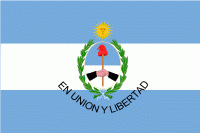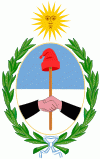San Juan Province (San Juan Province)
 |
 |
The province has an area of 89,651 km2, covering a mountainous region with scarce vegetation, fertile oases and turbulent rivers. Throughout the entire province there are an important number of paleontological sites.
Similar to other regions in Argentina, agriculture is one of the most important economic activities, highlighting wine production and olive oil. Additionally, a variety of fruits and vegetables are produced in the fertile valleys irrigated by artificial channels in the western part, close to the Andes mountain range. This is the second province in volume of wine production at the national level and in South America, and possesses outstanding varietal wines. It is also an important center of mining and oil production.
Before the arrival of Spanish conquistadores, different tribes like Huarpes, Diaguitas, Capazanes, Olongastas and Yacampis, highly influenced by the Inca empire, inhabited the area.
The city of San Juan de la Frontera was founded by Juan Jufré y Montesa in 1562 and relocated 2 kilometres south in 1593 due to the frequent flooding of the San Juan River.
In 1776, San Juan was annexed to the Viceroyalty of the Río de la Plata, becoming one of the cities of the Province of Cuyo. In the same year, the first recorded earthquake caused massive damage to the city.
The father of Argentine independence, Gen. Jose de San Martin, was appointed Governor of the Province of Cuyo in 1814. From there, San Martin began his legendary crossing of the Andes, one of military history's great tactical decisions. San Juan, then a small town, was a great supporter of the expedition supplying gold, men and mules.
In 1820, San Juan was granted autonomy from the Province of Cuyo, thereby becoming an autonomous province. The remainder of Cuyo region became Mendoza Province.
Following an era of international isolation for Argentina, the advent of new, more liberal government in 1853 attracted a number of exiled intellectuals back into San Juan. Among these, was a San Juan military officer and novelist named Domingo Sarmiento. Sarmiento was eventually elected governor in 1862, pursuing sorely needed public investments and enacting Argentina's first law mandating compulsory education (at that time about 80% of the adult population lacked any form of education). Once elected President of Argentina in 1868, those policies became national law.
In 1944 a moderate, yet highly destructive earthquake near the capital destroyed most of the city and killed 10,000 people. A fundraiser was organized to raise money for the victims of the quake where Colonel Juan Perón met his eventual wife and political companion Eva Duarte.
Map - San Juan Province (San Juan Province)
Map
Country - Argentina
 |
 |
| Flag of Argentina | |
The earliest recorded human presence in modern-day Argentina dates back to the Paleolithic period. The Inca Empire expanded to the northwest of the country in Pre-Columbian times. The country has its roots in Spanish colonization of the region during the 16th century. Argentina rose as the successor state of the Viceroyalty of the Río de la Plata, a Spanish overseas viceroyalty founded in 1776. The declaration and fight for independence (1810–1818) was followed by an extended civil war that lasted until 1861, culminating in the country's reorganization as a federation. The country thereafter enjoyed relative peace and stability, with several waves of European immigration, mainly Italians and Spaniards, radically reshaping its cultural and demographic outlook; over 60% of the population has full or partial Italian ancestry, and Argentine culture has significant connections to Italian culture.
Currency / Language
| ISO | Currency | Symbol | Significant figures |
|---|---|---|---|
| ARS | Argentine peso | $ | 2 |
| ISO | Language |
|---|---|
| EN | English language |
| FR | French language |
| DE | German language |
| GN | Guarani language |
| IT | Italian language |
| ES | Spanish language |















